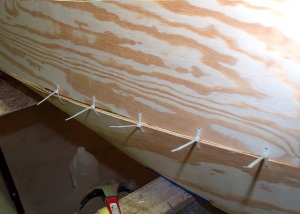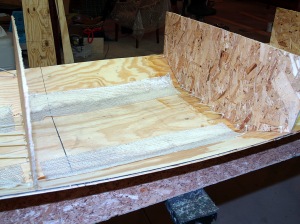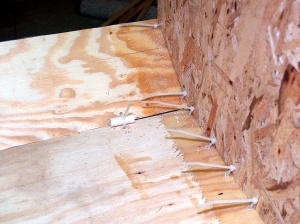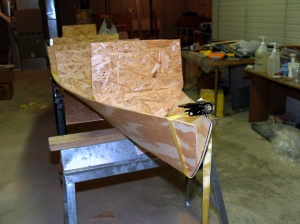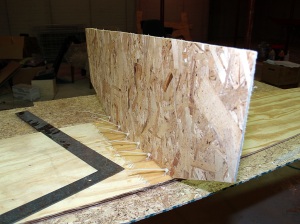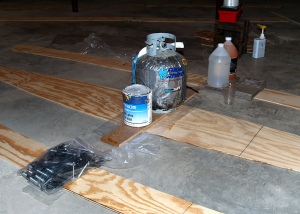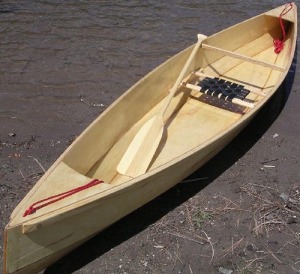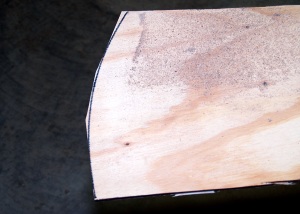As a public service for those readers that I just know are on the edges of their seats wondering about the status of various open issues, I hereby present a collection of updates:
– the Canoe Project: when I last spoke on this topic, I was at a loss as to how to get the lower and upper side panels to meet. I’m not so worried about the gap between the two; the bigger issue is that I can’t get them flush. My efforts to rectify that had been concentrated on getting the lower panel to move inward to match the edge of the upper panel, but no amount of coercion could convince it to do so. I was down in the Boatworks a few days ago on an unrelated mission, and took the opportunity to take a fresh look at the problem. Now I grant you, this is going to seem painfully obvious in hindsight, but it appears that it will be quite easy to shim the upper panel away from the temporary bulkhead such that it moves outboard enough to line up with the lower panel. Yeah, like I said: “Duh!”
– the Miata: if you recall, it nearly left me stranded clear across town when the clutch wouldn’t disengage enough to allow me to get it into gear. I made an adjustment to the length of the clutch pushrod in order to get home, then stuffed the car back in the garage behind the snow plow and decided to just leave it there until, well, yesterday afternoon. I figured that maybe it was low on clutch fluid, so the first thing I did yesterday was pop the hood and check the level in the translucent plastic fluid reservoir. Which, thankfully, wasn’t back in the trunk with the battery. The level appeared to be mid-way between the Min and Max marks, but since I had needed a jump start again to get it started, I figured I could eradicate two avians with one projectile with a drive to the auto parts store to secure a container of DOT 3 brake/clutch fluid, which would also serve to push a new reserve of electrons into the battery. When I got back, I popped the lid on the reservoir, only to find it nearly bone dry. The reservoir was stained with the remains of fluid past, which presented a false level reading when viewed from the outside. Sigh.
– the Annual Condition Inspection: still waiting on the new gascolator. I ordered a new one from Aircraft Spruce last Friday, but cancelled the order when I received a very generous offer from an RV builder that had a gascolator that he would not be using. Many of you that attend Oshkosh each year will recognize the name of the donor, Mr. Bob Collins, as the driving force behind the annual BBQ. I had to renew the order for what turns out to be my old Model GAS-1 gascolator once I found out that the donated gascolator, a Model GAS-5, won’t fit the mount on my plane. That’s unfortunate because the newer model is much nicer than the old one, but I don’t want to have to refabricate the mount, at least not in the short term. Maybe when I replace the oil and fuel hoses later this year, though. In any event, thanks Bob!
– Shooting with my brother: finally having had all I can stand of the emasculating effect of showing up with .22 rimfires as he pulls out his gazillion caliber bazookas, I decided that I needed a grown-up rifle. But… I don’t hunt. I just like to make the thing go bang, and I like the mechanical precision of firearms. I enjoy the challenge of trying to consistently hit a target, and I like the congeneality I share with my brother when we have co-interests. With that in mind, you won’t be surprised to learn that I wasn’t keen on the idea of spending $600 – $800 for a new rifle. I have a friend at work that collects old military surplus guns, and he suggested that I look for one of those. I decided on a Chinese SKS. They’re commonly available at gun shows, moderately priced, and parts/ammo are cheap and also commonly available. I took it out and shot ten rounds through it last week to make sure it works, and found that it’s more pleasant to shoot than I had expected. It jumps a bit when you shoot it, but there is very little recoil that gets as far as your shoulder. In other words, you can shoot it all afternoon and not come home sore and/or bruised. I took a few pictures of it, if you’re curious:
http://picasaweb.google.com/HogarthKramer/SKS
It has a ten round internal magazine that loads through the top, but that’s kind of a pain in the nethers to do. I ordered a 20 round removeable magazine to replace it, and I found that it is much easier to load. Worth the $18. Oh, and if you must know, the gun itself was $265. They can be had far cheaper, but most of them at that price point look pretty ratty and run-down.




